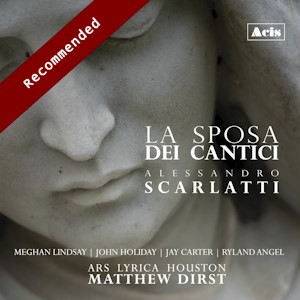
Alessandro Scarlatti (1660-1725)
La sposa dei cantici, oratorio (1710)
Meghan Lindsay (soprano): Sposa
John Holiday (countertenor): Sposo
Jay Carter (countertenor): Amore
Ryland Angel (countertenor): Eternità
Ars Lyrica Houston/Matthew Dirst
rec. 2014, Zilkha Hall, Hobby Center for the Performing Arts, Houston, USA
Italian text and English translation supplied
Acis APL53721 [2 CDs: 86]
Alessandro Scarlatti’s oratorio L’Assunzione della Beata Vergine (The assumption of the Blessed Virgin) was first heard in Rome in 1703. When the composer and the librettist revised it for a Naples performance in 1710, it became La sposa dei cantici (The songful bride). The changes go much further than the title. Matthieu Peyrègne and the Ensemble Baroque de Monaco recorded L’Assunzione in 2017 for Paraty (118176); they play 32 numbers in 63 minutes. La sposa dei cantici has 47 numbers which take 86 minutes, so it indeed, as Ars Lyrica Houston maintains, is a world premiere.
Scarlatti’s oeuvre is encountered far too seldom now for one of the great composers of the European Baroque, and one of the most productive. (What jewels lie entombed in the almost 100 operas?) We should be grateful for the restoration of any of his cantatas or oratorios; they do not sit on publishers’ shelves sensitively edited and ready for performance. Ars Lyrica’s Director Matthew Dirst and his colleague Jeffrey Ragsdale must have had much to do before the score could be performed and recorded. It sounds like work very well done. The piece transports us to the early 18th century in Naples, and to the quintessential sound of a master of Baroque Italian vocal style.
Cantatas and oratorios in Italian – often unpublished, so rarely revived – were staple in part because of a papal ban on opera. Scarlatti and others, including young Handel during his Italian years, wrote oratorios, often as here a love story and sacred allegory. They employed Baroque opera’s basic building blocks of da capo arias separated by recitative. With skilfully written text, a passionate operatic aria could also serve as deeply devoted sacred music.
La sposa dei cantici serves exactly this dual role. Matthew Dirst writes in his excellent booklet note that the two lead figures Sposa and Sposo(bride and groom) “can also be read as Mary and God, the Soul and the Church, the lovers from the Song of Songs, or even various mythological characters”. An ideal couple, then, representing the ideals of love. The other figures, Amore divino (Divine love) and Eternità(Eternity), are more abstractions than characters. Scarlatti gave these roles to altos, but Sposa and Sposoto sopranos; they could all have been castrati in 1710.
On this recording, a soprano sings Sposa, and three countertenors sing the rest. John Holiday’s countertenor signing Sposo is at times closer to a true male soprano. His remarkable voice, first heard in Dorme la mia diletta (My delightful one sleeps), follows straight on from Sposa’s singing, and sounds quite similar to it. His musicality is as impressive as his pure sound, and the effect of two voices which sound as one is captivating: lovers at this exalted level aspire not merely to be together but to become one another. They also enchant in the work’s catchy final duet, a sort of Baroque “invitation to the dance”.
Meghan Lindsay’s Sposa is no less superbly sung. She has a lovely basic sound, and she colours very well the different texts she has to sing. Amore (Jay Carter) and Eternità(Ryland Angel) are traditional countertenors, both excellent in sound and in vocal characterisation. This is a very strong team of voices. It is attuned to the style, alert to the way a da capo repeat needs differ subtly from the first time around. The variety in this score, not least the rhythmic variety, is a great strength. The artists sing with a freshness, even in the recitatives, which suggests they were delighted to discover the music. The authentic instruments, strings and continuo, have a delightful timbre, touching in lyrical moments and athletic in the execution of swifter passages. The concertmaster duets delightfully withSposa in Fide amiche donzellette (Faithful loving damsels), as does the solo cello in Sposo’s Vieni, vieni (Come, come).
Sposa’s Fide amiche is the longest number in the score at 4:21. The next longest at 3:41 is the closing duet, and all but one of the rest of the twenty-three numbers are under three minutes. This might seem a small point, but all you have to work with here is da capo arias, all for high voice with no chorus, and just strings and continuo. In such a work, you better keep the music moving along, and as varying as the text permits. This is what Scarlatti achieves so as not to bore his private audience of prelates and dignitaries. And he delights us now that his long-buried treasure has resurfaced.
The sound is very good, and mostly well-balanced, except when a singer seemed loud or just too forward in the mix (Meghan Lindsay on track 3, and John Holiday on track 11). But these momentary glitches do not diminish one’s pleasure in the fine singing. Matthew Dirst is a very alert, sympathetic director, and he often gives a discreet ‘lift’ to the dance-like numbers. We should be grateful that he and his forces do such justice to this three-centuries-old brand new piece.
Roy Westbrook
Availability: Acis Productions


















